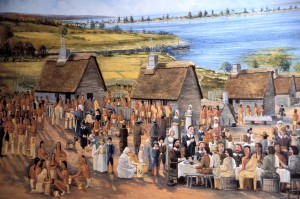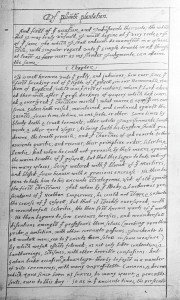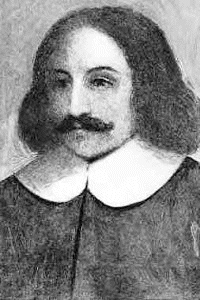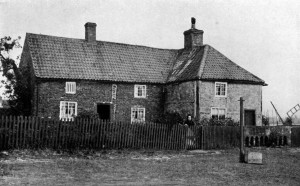To my great surprise, I recently discovered that my 14th great-grandfather, William Bradford, was one of the first men to set foot on American soil. Not only was William Bradford a descendant of the Mayflower, he was also the leader of a majority of the pilgrims, otherwise known as Congregationalists, one of the founders and the governor of Plymouth Colony for 31 years, and the author of Of Plymouth Colony, one of the most important early chronicles of the New England settlement.
William, pictured on the left, was born in Austerfield, Yorkshire, a small farming town, in 1590. The picture below features the house that William was born in. When William was only one year old, his father passed away, and six years later he lost his mother as well. William and his sister, Alice Bradford, were then raised by their uncle, Robert Bradford.
William was what we would call today a rebel. After becoming quite familiar with the Bible, William had developed his own beliefs and opinions on religion. At the age of 12, William lived in a town named Scrooby which neighbored Austerfield. The church in Scrooby was unlike any William had ever seen. With movements encouraging reform and change, William joined the Separatist church when he was only 17 years old. The king at the time, James I, began threatening prosecution to anyone separating from the Church of England, causing William and the rest of the Separatists to flee to Amsterdam. After only a year, William and the Separatists moved to Lieden, Holland, and resided there for the next eleven years.
At the age of 30, William and the rest of the church decided to embark on a journey to America to freely celebrate their religion. In 1620, Plymouth Colony was established and was shortly led by a man named John Carver. The governor died a year after beginning his term, and William was then elected governor and served for the next 30 years. William’s involvement in his colony was extensive, including being the head of government, overseeing the colony’s court systems and finance, and helping draft the colony’s legal code which regarded foreigners, Indians, and law. At age 33, William married his new wife, Alice Southworth, and together they had three children.

Historic painting of the famous first Thanksgiving feast of the 1621 harvest celebration at Plymouth that included the English colonists and the Wampanoag Indians
As it turns out, a large amount of credit can be given to William Bradford for somewhat creating the idea of Thanksgiving. After having a plentiful harvest in 1621, Bradford decided to celebrate and set up a feast with the native Indians. The pilgrims and Indians had gathered enough food to serve the plantation and many of the native Indians for about 5 days. It was this act of celebrating their harvest and being thankful for their survival had that become a tradition and was repeated every year. Ever since I was born, I can remember my family always making Thanksgiving the most extravagant holiday of the year. With food coming out of our ears and a house filled with family, it’s always nothing less than an annual feast. I am thankful for every Thanksgiving I’ve been able to spend with my family and I’d like to thank my very great-grandfather for contributing in the creation of this holiday.
Throughout his life’s journey, William kept a journal and used his passages to then write the full history of Plymouth Colony. He started his writings in 1630 and continued to document the colony’s history until 1651. His documentation of the colony’s history was eventually titled Of Plymouth Plantation and today has become a required reading for many college history courses. The figure to the right is the first page of Of Plymouth Plantation. After moving around the world, leading an entire colony, and living a happy life with his wife and children, William passed away on May 9th, 1657, when he was 68 years old. His legacy, however, still remains and his history still continues to exist as one of the primary sources used by historians today. Although I hadn’t realized that I was related to William until just recently, I like to think that some of my day to day tendencies and behaviors come from him. I’ve always stood up for what I believe in and never let another person tell me I was incapable of anything. I was a born leader and always give nothing but my best effort in everything I do. My 14th great-grandfather will always be a part of me and I hope my choices and leadership skills would make him proud.
of Plymouth Colony. He started his writings in 1630 and continued to document the colony’s history until 1651. His documentation of the colony’s history was eventually titled Of Plymouth Plantation and today has become a required reading for many college history courses. The figure to the right is the first page of Of Plymouth Plantation. After moving around the world, leading an entire colony, and living a happy life with his wife and children, William passed away on May 9th, 1657, when he was 68 years old. His legacy, however, still remains and his history still continues to exist as one of the primary sources used by historians today. Although I hadn’t realized that I was related to William until just recently, I like to think that some of my day to day tendencies and behaviors come from him. I’ve always stood up for what I believe in and never let another person tell me I was incapable of anything. I was a born leader and always give nothing but my best effort in everything I do. My 14th great-grandfather will always be a part of me and I hope my choices and leadership skills would make him proud.
Works Consulted:
Lochgarry. “Thanksgiving: A Reflection.” Lochgarrys Blog. N.p., 23 Nov. 2011. Web. 11 Nov. 2014.
Johnson, Caleb. “William Bradford.” MayflowerHistory.com. Caleb Johnson, n.d. Web. 10
Nov. 2014.
Kelso, Dorothy Honiss. “Beyond The Pilgrim Story.” Pilgrim Hall Museum – Beyond the Pilgrim Story –
William Bradford. Pilgrim Hall Museum, n.d. Web. 11 Nov. 2014.
Commonwealth of Massachusetts – (1900) Bradford’s History “Of Plimoth Plantation”. Boston: Secretary
of the Commonwealth.


